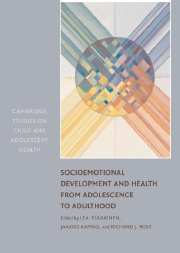Book contents
- Frontmatter
- Contents
- List of Contributors
- Preface
- Introduction
- PART I LONGITUDINAL AND BEHAVIORAL GENETIC APPROACHES
- PART II ADOLESCENT HEALTH-RELATED BEHAVIOR AND ADULT HEALTH
- PART III SOCIOEMOTIONAL BEHAVIOR IN EARLY ADOLESCENCE
- PART IV LIFE COURSE AND HEALTH
- Summary and Future Directions
- References
- Author Index
- Subject Index
Preface
Published online by Cambridge University Press: 07 December 2009
- Frontmatter
- Contents
- List of Contributors
- Preface
- Introduction
- PART I LONGITUDINAL AND BEHAVIORAL GENETIC APPROACHES
- PART II ADOLESCENT HEALTH-RELATED BEHAVIOR AND ADULT HEALTH
- PART III SOCIOEMOTIONAL BEHAVIOR IN EARLY ADOLESCENCE
- PART IV LIFE COURSE AND HEALTH
- Summary and Future Directions
- References
- Author Index
- Subject Index
Summary
Early chapters of this jointly edited and multi-authored book review the history, design, and rationale of two ongoing longitudinal research programs conducted in Finland; subsequent chapters present a diverse set of empirical findings from the two sets of studies. Those results aim to offer an integrated perspective of continuities in behavior from childhood into adulthood via analyses of individual and familial predictors of adult outcomes, with emphasis placed on health-related longitudinal findings.
The first of the two research efforts began as a cross-sectional study of 8-year-old Finnish schoolchildren; designed and conducted by Pulkkinen as her doctoral dissertation and completed in 1969, the dissertation study evolved into the Jyväskylä Longitudinal Study of Personality and Social Development (JYLS). Now that the original study participants have aged into mid-life, their children are enrolled in ongoing study protocols. The first of the two FinnTwin studies, reflecting six years of earlier collaboration between Rose and Kaprio, began baseline data collection in 1990 as consecutive birth cohorts of participant twins reached age 16; a second, more ambitious FinnTwin study, for which Pulkkinen joined Rose and Kaprio as a co-investigator, began baseline assessment of twins at ages 11–12 in 1994. That study adapted assessments from the JYLS for use with twin children to yield genetically informative information on socioemotional behavior in childhood as a complement to results obtained decades earlier on participants in the JYLS.
- Type
- Chapter
- Information
- Socioemotional Development and Health from Adolescence to Adulthood , pp. xv - xviiiPublisher: Cambridge University PressPrint publication year: 2006

